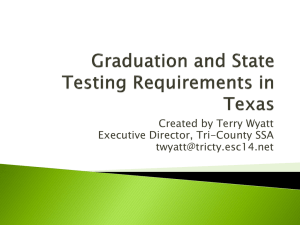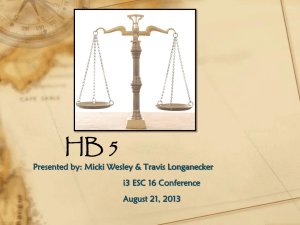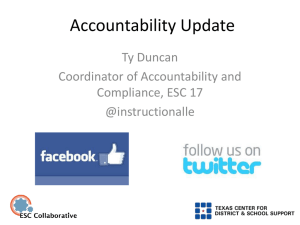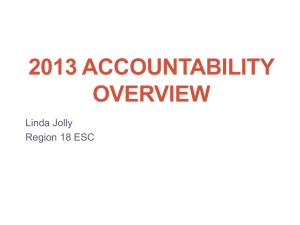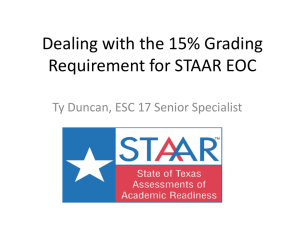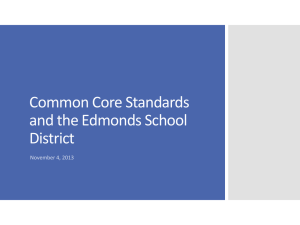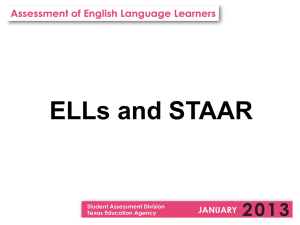STAAR
advertisement
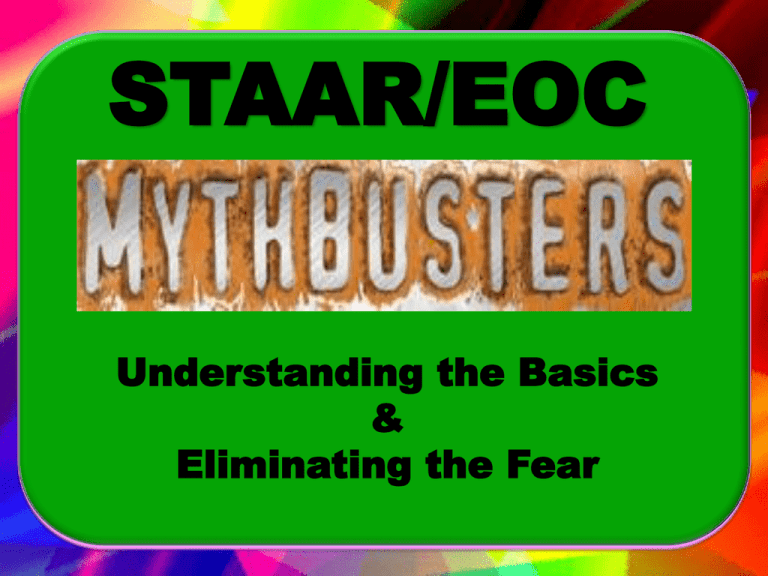
STAAR/EOC Understanding the Basics & Eliminating the Fear 2 3 STAAR MYTH or TRUTH? STAAR is actually a college level test. 4 STAAR STAAR is more rigorous than TAKS, but content is 100% tied to the required curriculum with an emphasis on alignment to college and career readiness 5 STATE OF TEXAS ASSESSMENTS OF ACADEMIC READINESS (STAAR) • More rigorous than TAKS; greater emphasis on alignment to college and career readiness • Grades 3−8 tests are in same grades and subjects as TAKS 6 STATE OF TEXAS ASSESSMENTS OF ACADEMIC READINESS (STAAR) • High school - twelve end-of-course (EOC) assessments in the four foundation content areas replace the current high school TAKS tests – *English I, *English II, **English III – *Algebra I, *Geometry, Algebra II – *Biology, Chemistry, Physics – *World Geography, *World History, **U.S. History *Current Modified Versions **Phase in Modified Versions 2013-2014 7 STAAR MYTH or TRUTH? Beginning in 2012-2013 the EOC assessment score will count as 15% of a student’s final grade in the course. 8 STAAR Myth or Truth? Districts are required to count STAAR Modified / STAAR Alternate EOC assessment scores as 15% of a student’s final course grade. 9 Grading Requirements • Beginning with the 2012-2013 school year, the EOC score will count 15% of the student’s final grade in the course. • There is no corresponding requirement for students taking a modified or alternate assessment, so districts are not required to count STAAR Modified or STAAR Alternate EOC assessment scores as 15% of a student’s final course grade. • Course credit, including first semester, will not be awarded for courses requiring an EOC exam until receipt of EOC scores 10 STAAR MYTH or TRUTH? STAAR/EOC assessments may be given anytime a student completes a course. 11 STAAR STAAR/EOC assessments will only be offered 3 times a year. Fall, spring and summer. 12 Grading Requirements • Student’s may retake an EOC exam at any time according to the testing schedule – SUMMER (July - All) – FALL (December – All) – SPRING (March - English) (May – Math, Science, SS) 13 STAAR Myth or Truth? A student may only retake an EOC if he/she fails the assessment. 14 STAAR A student may retake any EOC for any reason. 15 Grading Requirements • If a student retakes an EOC assessment to gain credit for the course, the District will include the retake score as 15% of the final course grade – Once credit is earned, subsequent EOC scores will not be included in calculation of final course grade – Retake scores will not be used for calculation of GPA/Class Rank 16 STAAR Myth or Truth? A Student is required to retake a course if they do not meet minimum standard on a STAAR/ EOC assessment. 17 STAAR Students ARE NOT required to retake a course in order to retake a STAAR/EOC Assessment. 18 Grading Requirements • Students who do not have a passing average in the course will need to retake the course • Students who do not meet the minimum standard for the EOC will need to retake the EOC 19 STAAR Myth or Truth? The new performance standards are unsatisfactory, satisfactory and commended. 20 Performance Categories Students must reach at least the minimum score. MINIMUM SCORE Level I: Unsatisfactory Academic Performance Level II: Satisfactory Academic Performance Level III: Advanced Academic Performance 21 Performance Categories Level III: Advanced Academic Performance • well prepared for the next grade or course • demonstrate the ability to think critically • apply the assessed knowledge and skills in varied contexts, both familiar and unfamiliar • high likelihood of success in the next grade or course with little or no academic intervention • for Algebra II and English III, this level of performance also indicates students are well prepared for postsecondary success 22 Performance Categories Level II: Satisfactory Academic Performance • sufficiently prepared for the next grade or course • demonstrate the ability to think critically and apply the assessed knowledge and skills in familiar contexts • have a reasonable likelihood of success in the next grade or course but may need short-term, targeted academic intervention • for Algebra II and English III, this level of performance also indicates students are sufficiently prepared for postsecondary success. 23 Performance Categories Level I: Unsatisfactory Academic Performance • inadequately prepared for the next grade or course • do not demonstrate a sufficient understanding of the assessed knowledge and skills • unlikely to succeed in the next grade or course without significant, ongoing academic intervention 24 STAAR MYTH or TRUTH? The State of Texas has set Phase-in Performance Standards for EOC assessments. 25 26 27 28 29 30 31 32 STAAR Myth or Truth? To graduate under STAAR, a student must achieve a cumulative score in each content area EQUAL TO OR GREATER THAN the number of EOCs taken in that content area X the passing 33 scale score. STAAR Students must achieve a cumulative score in each content area ≥ the number of EOCs taken in that content area x the passing scale score. 34 Graduation Requirements (Cumulative Score) • A cumulative score in English, Math, Science and Social Studies is required for graduation Examples: English I + English II + English III > Cumulative Score Algebra I + Geometry + Algebra II ≥ Cumulative Score Biology + Chemistry + Physics > Cumulative Score World Geography + World History + U.S. History > Cumulative Score 35 STAAR MYTH or TRUTH? ALL EOC scores count towards the cumulative average. 36 Graduation Requirements (Cumulative Score) • A student must achieve at least the minimum score in order for the score to count toward the cumulative average • Students scoring below the minimum standard – must receive remediation – must retake the assessment 37 STAAR MYTH or TRUTH? Student’s who score at the Minimum Performance Level on the EOC do not have to retake the assessment. 38 Graduation Requirements (Cumulative Score) • Students scoring at the Minimum Performance Level will be highly encouraged to retake assessments until a “Satisfactory” or “Advanced” performance score is obtained • Cumulative score requirements do not apply to students taking STAAR Modified or STAAR Alternate 39 STAAR Myth or Truth? The TEA gave school districts detailed instructions on how to convert raw EOC scores. 40 STAAR/EOC Grading Policies & Procedures 2012-2013 Converting Raw EOC Scores Level 1 – Unsatisfactory Level 2 – Satisfactory Level 3 – Advanced Academic FINAL COURSE GRADE Course - 85% EOC - 15% Level 1 = 69 Level 2 = 89 Level 3 = 99 Perfect Score = 100 1st Sem = 42.5% EOC Test = 7.5% 2nd Sem = 42.5% EOC Test = 7.5% READING/WRITING Each test calculated at 7.5% RETAKES For Course Credit Will include as part of final grade if retake score allows students to gain credit. Once credit is earned, subsequent EOC scores will not be included in calculation of final course grade. GPA/Class Rank EOC first administration scores will be calculated for final grade/GPA/class rank purposes Course Credit/Provisional Grades Will not be awarded until receipt of EOC scores. First semester 41 of EOC scores. scores will be provisional until receipt Graduation Requirements Distinguished High School Plan • 12 STAAR/EOC Assessments • Meet the cumulative score requirement in each of the 4 content areas • Achieve Level III (Advanced Academic Performance) on the College and Career Readiness Component of the – English III assessment and – Algebra II assessment 42 Graduation Requirements Recommended High School Plan • 12 STAAR/EOC Assessments • Meet the cumulative score requirement in each of the 4 core content areas • Achieve Level II (Satisfactory Academic Performance) on – English III assessment and – Algebra II assessment 43 Graduation Requirements Minimum High School Plan • Cumulative score is based on the number of courses taken for which there is a STAAR/EOC Assessment • Cumulative score requirement may vary by subject area 44 GRADUATION REQUIREMENTS 45 Cumulative Score – Math Example • Satisfactory Academic Performance (Level II) in Math is a scale score of 3500 points – To graduate, a student who takes all 3 STAAR/EOC tests in Math would need to achieve a Cumulative Score of 10,500 points (3 X 3500 = 10,500) • The minimum score is a scale score of: – Algebra I = 3371 – Geometry = 3362 – Algebra II = 3350 (Level III = 4080) 46 Cumulative Score - Math Example Student A Student B Student C Algebra I 3500 3371 3651 Geometry 4000 3500 3362 Algebra II 3000 3500 3500 Cumulative Score 7,500 10,371 10,513 No No Yes Met CS in Math? Reason Did not meet Minimum Score in Algebra II *Cannot graduate on RHSP CS did not add to 10,500. *Could retake any math test to raise CS *Met minimum in Geom. Although didn’t pass, still counts towards CS 47 48 Understanding the Basics & Eliminating the Fear! 49


